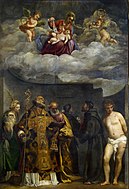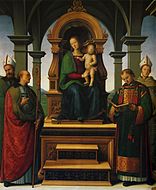Vatican Museums
Musei Vaticani | |
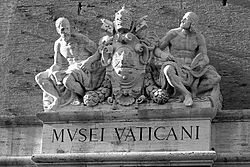 Sculptures above the exits of museums | |
| Established | 1506 |
|---|---|
| Location | Vatican City |
| Coordinates | 41°54′23″N 12°27′16″E / 41.90639°N 12.45444°E |
| Type | Art museum |
| Visitors | 6 million (2013)[1] |
| Director | Barbara Jatta[2] |
| Website | Official website |

| Part of a series on the |
| Vatican Museums |
|---|
 |
The Vatican Museums (Template:Lang-it) are Christian and art museums located within the city boundaries of the Vatican City. They display works from the immense collection built up by the Popes throughout the centuries including some of the most renowned classical sculptures and most important masterpieces of Renaissance art in the world. The museums contain roughly 70,000 works, of which 20,000 are on display,[3] and currently employ 640 people who work in 40 different administrative, scholarly, and restoration departments.[4]
Pope Julius II founded the museums in the early 16th century. The Sistine Chapel, with its ceiling decorated by Michelangelo and the Stanze di Raffaello decorated by Raphael, are on the visitor route through the Vatican Museums. In 2013, they were visited by 6 million people, which combined makes it the 6th most visited art museum in the world.[1]
There are 54 galleries, or sale, in total,[citation needed] with the Sistine Chapel, notably, being the very last sala within the Museum. It is one of the largest museums in the world.
In 2017, the Museum's official website and social media presence was completely redone, in accord with current standards and appearances for modern websites.[5]
History
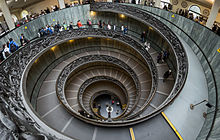
The Vatican Museums trace their origin to one marble sculpture, purchased 500 years ago: the sculpture of Laocoön and his Sons was discovered 14 January 1506, in a vineyard near the basilica of Santa Maria Maggiore in Rome. Pope Julius II sent Giuliano da Sangallo and Michelangelo Buonarroti, who were working at the Vatican, to examine the discovery. On their recommendation, the pope immediately purchased the sculpture from the vineyard owner. The pope put the sculpture of Laocoön and his sons on public display at the Vatican exactly one month after its discovery.
The Museum Christianum was founded by Benedict XIV, and some of the Vatican collections formed the Lateran Museum, which Pius IX founded by decree in 1854.[6]
The Museums celebrated their 500th anniversary in October 2006 by permanently opening the excavations of a Vatican Hill necropolis to the public.[7]
On 1 January 2017 Barbara Jatta became the Director of the Vatican Museums, [8] replacing Antonio Paolucci who had been director since 2007.[9]
Pinacoteca Vaticana
The art gallery was housed in the Borgia Apartment until Pope Pius XI ordered construction of a proper building. The new building, designed by Luca Beltrami, was inaugurated on 27 October 1932.[10] The museum has paintings including:
- Giotto's Stefaneschi Triptych
- Olivuccio di Ciccarello, Opere di Misericordia
- Raphael's Madonna of Foligno, Oddi Altarpiece and Transfiguration
- Leonardo da Vinci's St. Jerome in the Wilderness
- Caravaggio's Entombment
- Perugino's Madonna and Child with Saints and San Francesco al Prato Resurrection
- Filippo Lippi's Marsuppini Coronation
- Jan Matejko's Sobieski at Vienna
Collection of Modern Religious Art
The Collection of Modern Religious Art was added in 1973[11] and houses paintings and sculptures from artists like Carlo Carrà, Giorgio de Chirico, Vincent van Gogh, Paul Gauguin, Marc Chagall, Paul Klee, Salvador Dalí, and Pablo Picasso.
Sculpture museums
The group of museums includes several sculpture museums surrounding the Cortile del Belvedere.
Museo Pio-Clementino



The museum takes its name from two popes, Clement XIV and Pius VI, the pope who brought the museum to completion. Clement XIV came up with the idea of creating a new museum in Innocent VIII's Belvedere palace and started the refurbishment work.[14]
Pope Clement XIV founded the Pio-Clementino museum in 1771, and originally it contained the Renaissance and antique works. The museum and collection were enlarged by Clement's successor Pius VI. Today, the museum houses works of Greek and Roman sculpture. Some notable galleries are:
- Greek Cross Gallery: (Sala a Croce Greca): with the porphyri sarcophagi of Constance and Saint Helen, daughter and mother of Constantine the Great.
- Sala Rotonda: shaped like a miniature Pantheon, the room has impressive ancient mosaics on the floors, and ancient statues lining the perimeter, including a gilded bronze statue of Hercules.
- Gallery of the Statues (Galleria delle Statue): as its name implies, holds various important statues, including Sleeping Ariadne and the bust of Menander. It also contains the Barberini Candelabra.
- Gallery of the Busts (Galleria dei Busti): Many ancient busts are displayed.
- Cabinet of the Masks (Gabinetto delle Maschere): The name comes from the mosaic on the floor of the gallery, found in Villa Adriana, which shows ancient theater masks. Along the walls, several famous statues are shown including the Three Graces.One wove the thread of life,second nurtured it, third cut it. They were created by Zeus (ROMAN form: Jupiter)
- Sala delle Muse: Houses the statue group of Apollo and the nine muses, uncovered in a Roman villa near Tivoli in 1774, as well as statues by important ancient Greek or Roman sculptors. the center piece is Belvedere Torso, revered by Michelangelo and other Renaissance men.[15]
- Sala degli Animali: So named because of the many ancient statues of animals.

Museo Chiaramonti
This museum is named after Pope Pius VII (whose last name was Chiaramonti before his election as pope), who founded it in the early 19th century. The museum consists of a large arched gallery in which sides are exhibited several statues, sarcophaguses and friezes. The New Wing, Braccio Nuovo built by Raffaele Stern, houses important statues like The Prima Porta Augustus, Doryphorus, and The River Nile. Galeria Lapidaria is another part of Chiaramonti museum, with more than 3,000 stone tablets and inscriptions, which is the world's greatest collection of its kind. However, it is opened only by special permission, usually for reasons of study.
Museo Gregoriano Etrusco
Founded by Pope Gregory XVI in 1836, this museum has eight galleries and houses important Etruscan pieces, coming from archaeological excavations.[16] The pieces include: vases, sarcophagus, bronzes and the Guglielmi Collection.
Museo Gregoriano Egiziano
This museum houses a grand collection artifacts dating from Ancient Egypt.[17] Such material includes papyruses, the Grassi Collection, animal mummies, and reproductions of the famous Book of the Dead.[18]
History
The Museo Gregoriano Egiziano was inaugurated 2 February 1839 to commemorate the anniversary of Gregory XVI's accession to the papacy. The creation of the Museo Gregoriano Egiziano was particularly close to the pope's heart as he Believed the Understanding of the ancient Egyptian civilisation was vital in terms of its scientific importance as well as its value in understanding the old testament. This Felling was declared in a paper by the museums first curator, the skilled physiologist barbanite father Luigi Maria Ungarelli.[14]
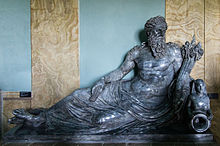
Vatican Historical Museum
The Vatican Historical Museum (Template:Lang-it) was founded in 1973 at the behest of Pope Paul VI,[19] and was initially hosted in environments under the Square Garden. In 1987 it was moved to the main floor of the Apostolic Palace of the Lateran and opened in March 1991.
The Vatican Historical Museum has a unique collection of portraits of the Popes from the 16th century to date, the memorable items of the Papal Military Corps of the 16–17th centuries and old religious paraphernalia related to rituals of the papacy. Also on display on the lower floor are the papamobili (Popemobiles); carriages and motorcars of Popes and Cardinals, including the first cars used by Popes.[20]
Highlights from the Painting Collection
-
Leonardo da Vinci
St. Jerome in Wilderness, 103 x 75 cm. -
Giotto di Bondone
Stefaneschi Triptych, 224 x 245 cm -
Giovanni Bellini
Pieta, 106 x 84 cm. -
Raphael
Oddi Altarpiece, 272 x 165 cm -
Raphael
Transfiguration, 405 x 278 cm. -
Raphael
Madonna of Foligno, 320 x 194 cm. -
Titian
Frari Madonna, 338 x 270 cm. -
Caravaggio
Entombment, 300 x 203 cm. -
Veronese
The Vision of St. Helen, 166 x 134 cm. -
Correggio
Christ in Glory, 105 x 98 cm. -
Titian
Portrait of Doge Marcello -
Perugino
Decemviri Altarpiece, 193 x 165 cm. -
Raphael
Adoration of the Magi
27 x 50 cm. -
Raphael
Annunciation
27 x 50 cm. -
Raphael
Presentation in the Temple
27 x 50 cm.
Other Highlights in the Museum

- The red marble papal throne, formerly in the Basilica di San Giovanni in Laterano;
- Roman sculpture, tombstones, and inscriptions, including the Early Christian Sarcophagus of Junius Bassus and Dogmatic sarcophagus, and the epitaph of Lucius Cornelius Scipio Barbatus;
- The Raphael Rooms with many works by Raphael and his workshop, including the masterpiece The School of Athens
- The Niccoline Chapel
- The Sistine Chapel, including the Sistine Chapel ceiling.
- The Gallery of Maps: topographical maps of the whole of Italy, painted on the walls by friar Ignazio Danti of Perugia, commissioned by Pope Gregory XIII (1572–1585). It remains the world's largest pictorial geographical study.
- The frescoes and other works in the Borgia Apartment built for Pope Alexander VI (Borgia).
- The double spiral staircase, designed by Giuseppe Momo in 1932. The staircase has two parts, a double helix, and is of shallow incline, being a stepped ramp rather than a true staircase. It is encircles the outer wall of a stairwell of approximately fifteen metres (49 feet) wide and with a clear space at the centre. The balustrade around the ramp is of ornately worked metal
Visitors
Nearly 6 million people visited the Vatican Museums in 2013. This is three times the figure of 30 years ago.[21]
See also

- Accademia, Venice
- Uffizi, Florence
- Index of Vatican City-related articles
- List of most visited art museums in the world
References
- ^ a b Top 100 Art Museum Attendance, The Art Newspaper, 2014. Retrieved on 13 July 2014.
- ^ http://kobieta.wp.pl/to-ona-rzadzi-w-watykanie-kim-jest-barbara-jatta-6075491162485889a
- ^ "Meet Antonio Paolucci - Divento". www.divento.com. Retrieved 2016-12-28.
- ^ Jatta, Barbara (16 October 2016). "The Vatican Museums: transformation of an organisation" (PDF). Retrieved 28 December 2016.
- ^ http://press.vatican.va/content/salastampa/it/bollettino/pubblico/2017/01/23/0050/00117.html
- ^ Herbermann, Charles, ed. (1913). . Catholic Encyclopedia. New York: Robert Appleton Company.
- ^ Barbara McMahon in Rome. "Guardian.co.uk". Guardian. Retrieved 2014-08-21.
- ^ Jatta has been serving ..., Catholic Herald, Retrieved 21 December 2016
- ^ Rykner, Didier. "Antonio Paolucci, the new Director of the Vatican Museums". The Art Tribune. Retrieved 27 December 2016.
- ^ "Pinacoteca". Mv.vatican.va. 1932-10-27. Retrieved 2014-08-21.
- ^ "The Vatican Museums". www.vaticanstate.va. Retrieved 2016-12-29.
- ^ D.B. Saddington (2011) [2007]. "the Evolution of the Roman Imperial Fleets," in Paul Erdkamp (ed), A Companion to the Roman Army, 201-217. Malden, Oxford, Chichester: Wiley-Blackwell. ISBN 978-1-4051-2153-8. Plate 12.2 on p. 204.
- ^ Coarelli, Filippo (1987), I Santuari del Lazio in età repubblicana. NIS, Rome, pp 35-84.
- ^ a b Bertoldi, Susanna (2011). The Vatican Museum: Discover the history, the works of art, the collections. Vatican city: sillabe. pp. 46, 96. ISBN 978-88-8271-210-5.
- ^ Montebello, Philippe De; Kathleen Howard (1983). "Sala delle Muse". The Vatican: Spirit and Art of Christian Rome. Metropolitan Museum of Art. pp. 178–180. ISBN 9780870993480.
- ^ "Museo Gregoriano Etrusco". Mv.vatican.va. Retrieved 2014-08-21.
- ^ "Gregorian Egyptian Museum". Mv.vatican.va. Retrieved 2014-08-21.
- ^ [1] Archived July 5, 2011, at the Wayback Machine
- ^ Guida ai musei e alla Città del Vaticano. Ediz. inglese (in Italian). Edizioni Musei Vaticani. 1986. ISBN 978-88-86921-11-4. Retrieved 9 May 2013.
- ^ "Museo Storico Vaticano (San Giovanni)". 060608.it. Retrieved 9 May 2013.
- ^ Tully, Shawn (14 August 2014). "This Pope Means Business". Fortune. Retrieved March 26, 2016.
Further reading
- G. Spinola, Il Museo Pio-Clementino (3 vols., 1996, 1999, 2004)
- G. B. Visconti and E. Q. Visconti, Il Museo Pio-Clementino Descritto (8 vols., 1782–1792)
- The Vatican: spirit and art of Christian Rome. New York: The Metropolitan Museum of Art. 1982. ISBN 0870993488.
External links
- Vatican Museums
- Museums in Vatican City
- 1506 establishments in the Papal States
- Art museums and galleries in Rome
- Art museums established in 1506
- Egyptological collections in Italy
- Museums of Ancient Greece
- Museums of Ancient Rome
- Museums of Dacia
- National museums
- Organizations established in the 1500s
- Religious museums in Italy
- Vatican City culture
- Double spiral staircases
- Rome Q. XIV Trionfale








